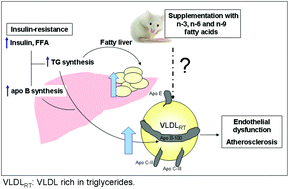Supplementation with n-3, n-6, n-9 fatty acids in an insulin-resistance animal model: does it improve VLDL quality?
Abstract
Insulin-resistance (IR), of increased cardiovascular risk, is characterized by the production of altered VLDL with greater atherogenicity. Dietary fatty acids influence the type of circulating VLDL. But, it is not clear how dietary fatty acids impact VLDL characteristics in IR. Aim: to evaluate the effects of n-3, n-6 and n-9 fatty acid supplementation on preventing atherogenic alterations in VLDL, in a diet-induced IR rat model. Male Wistar rats (180–200 g) were fed: standard diet (control, n = 8) and a sucrose rich diet (30% sucrose in water/12 weeks, SRD; n = 24). Simultaneously, SRD was subdivided into SRD-C (standard diet), and three other groups supplemented (15% w/w) with: fish oil (SRD-n3), sunflower oil (SRD-n6) and high oleic sunflower oil (SRD-n9). Lipid profile, free fatty acids, glucose, and insulin were measured. Isolated VLDL (d < 1.006 g ml−1) was characterized by chemical composition and size (size exclusion-HPLC). In comparison with SRD-C: SRD-n3 showed an improved lipoprotein profile (p < 0.01), with lower levels of insulin and HOMA-IR (p < 0.05). SRD-n6 showed increased levels of HDL-cholesterol and lower insulin levels. SRD-n9 did not exhibit differences in lipid and IR profile, and even favored weight gain and visceral fat. Only SRD-n3 prevented the alterations in VLDL-TG% (54.2 ± 4.4% vs. 68.6 ± 8.2, p < 0.05) and showed lower large VLDL-% (22.5[19.7–35.6] vs. 49.1[15.5–82.0], p < 0.05), while SRD-n6 and SRD-n9 did not show effects. Conclusion: In IR, while n-3 PUFA showed expected favorable effects, supplementation with n-6 PUFA and n-9 MUFA did not prevent atherogenic alterations of VLDL. Thus, the recommendations of supplementation with these fatty acids in general diet should be revised.



 Please wait while we load your content...
Please wait while we load your content...